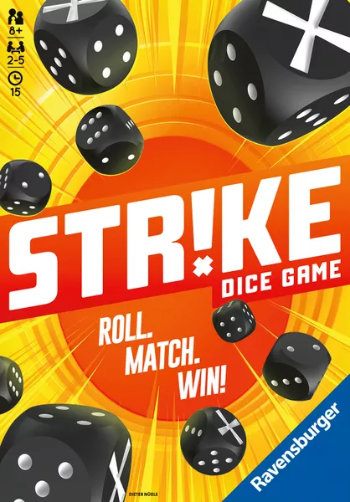Strike Board Game Review

By MARK WILSON

Year Published: 2012
Players: 2-5
Playing Time: 15 Minutes
Strike shouldn’t work. At least not as well as it does. Any description of the game, including a full rules teach, will leave a lot of people saying “that’s it?”
The beauty is in the minimalism, though. The directness. The sheer stupidity that this is what passes for a marketable game.
But there’s also some brilliance in that fact. I’m not joking when I say that I can list on one hand the number of games I’ve had more fun with than Strike in the past few years. Actually, let’s extend that from “the last few years” to “ever.”
I also have yet to play Strike where we didn’t immediately play it at least a 2nd time, and often more. That is an unparalleled feat in gaming for me, even among 5-15 minute filler games.
Strike Summary
There’s some dice numbered 2-6 (the final side is an X) and an arena that sits inside the game box. You each get a number of dice based on player count.
On your turn, you roll dice one at a time until your turn is over. You have to chuck at least one die on your turn, but can pass after that. If you ever match two dice, you collect them and your turn ends. Any X’s are removed from the game entirely. You can strike other dice to turn them over to try to create multiple matches and collect more dice.
If you manage to clear the arena of dice, the next player has to roll all of their dice at once.
Last person with dice in their pool wins. And that’s the entirety of the game.
Components – What Brings an Idiom to Life
This game is easily proxied with some generic six-sided dice and a colander, box top, or similar “arena” for rolling in. But I’m about to make the case that the official copy is worth owning instead of doing this.
The arena itself is somehow important. The shape of it suggests ancient Roman combat. I couldn’t tell you why it matters. But it does. It lends a certain amount of gravitas to the proceedings. We’re battling in a gladiatorial arena, not just playing an abstract dice-chucker.
The X’s on the dice, too, are an amusing warning and clear indicator that things have gone south. “Ooooh” everyone will exclaim when eight dice are rolled and five of them come up X’s. I can’t imagine the same instant reaction if it were 1’s we were looking at.
It’s these little touches that elevate the game. It doesn’t require massive or overproduced components – you can probably find a secondhand copy of this for $10-$20 if you’re diligent and patient – but it requires components that subtly suggest the idiom in which the game asks you to place your mental state.
Why We Play Games
That rules summary didn’t sound incredibly exciting, did it? It didn’t to me initially either, largely because I’m wired for strategic games these days as much as goofy party games.
Stated differently, hobby gaming misses the point sometimes. So I think we need to turn to family gaming to get a sense of Strike’s appeal.
Imagine you’re a kid who just wants to huck dice into one another, watching them toss and tumble and crying out with each lucky roll or bad beat. You’re laughing at your sister, or she’s laughing at you, for some horrible roll, but then the tide turns and everyone exclaims in incredulous wonder as four 6s magically appear.
Now imagine that this is equally as fun as an adult. Because it is.
It won’t be for everyone. But the few negative comments I’ve seen seem to be missing the point. “Why is this even a game?” they’ll ask, either explicitly or implicitly.
The answer, of course, is that sometimes we just want to huck dice at one another and laugh and scream at the outcomes together. This is a bonding experience that strategy games often struggle to recreate, because the focus is elsewhere. The bond could be with your kids and spouse. But it could also facilitate bonds between strangers, or your mates at the pub. Strike works equally well in these situations.
It’s my icebreaker game, my beginning-of-the-night game, my end-of-the-night game, my “Suzy will be here in 20 minutes, let’s play a couple rounds of Strike” game…wherever I need it, really.
And for some reason, taunts of “just roll better” or “get good, scrub!” work in this game. Yes, it’s (almost) entirely luck, but it feels personal. Your outcomes feel earned, good or bad. “We can’t let Alec keep getting away with this!” is another. How, exactly, should you stop Alec? Roll better, of course. Sure, you can try to manipulate the outcomes so that he doesn’t have great odds on his turn. A few small tactical decisions can inform this. But mostly, you just need to get good, scrub. Silly me, how could I forget that?
Strike – Conclusions
This is why I play games. To laugh and groan and screw around over drinks or food with good friends. This isn’t just a palette cleanser or filler game, it can be a valid final destination for the type of experience you consistently want to have around a table with friends.
I have owned 10-minute games that simply fill a gap of time. These are not worth my time, because they’re merely existing. I’d rather spend that time relaxing and chatting with those around me. Games do not need to fill every gap in our gaming time if we’re with those whose company we enjoy.
Strike, though, is not merely filling that space. It’s enhancing it. It’s why it’s one of my most played games ever, and most requested games ever.
…
Like my content and want more? Check out my other reviews and game musings!
Read More From Bumbling Through Dungeons
Recent Posts
Categories
- All (350)
- Announcements (4)
- Board Games (203)
- DMing (28)
- Game Design (16)
- Playing TTRPGs (22)
- Reviews (189)
- RPGs (142)
- Session Reports (91)
- Why Games Matter (9)